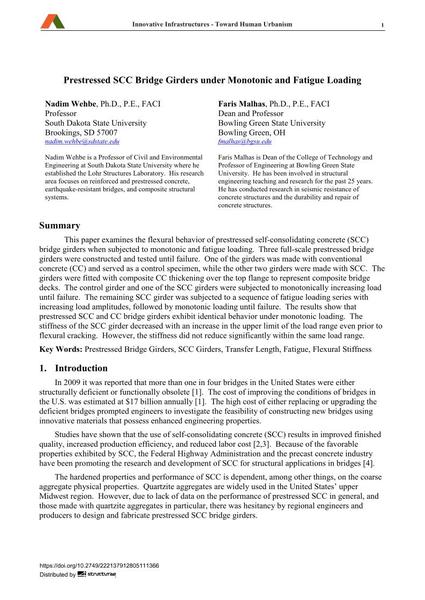Prestressed SCC Bridge Girders under Monotonic and Fatigue Loading

|
|
|||||||||||
Bibliografische Angaben
| Autor(en): |
Nadim Wehbe
Faris Malhas |
||||
|---|---|---|---|---|---|
| Medium: | Tagungsbeitrag | ||||
| Sprache(n): | Englisch | ||||
| Tagung: | 18th IABSE Congress: Innovative Infrastructures – Towards Human Urbanism, Seoul, Korea, 19-21 September 2012 | ||||
| Veröffentlicht in: | IABSE Congress Seoul 2012 | ||||
|
|||||
| Seite(n): | 927-934 | ||||
| Anzahl der Seiten (im PDF): | 8 | ||||
| DOI: | 10.2749/222137912805111366 | ||||
| Abstrakt: |
This paper examines the flexural behavior of prestressed self-consolidating concrete (SCC) bridge girders when subjected to monotonic and fatigue loading. Three full-scale prestressed bridge girders were constructed and tested until failure. One of the girders was made with conventional concrete (CC) and served as a control specimen, while the other two girders were made with SCC. The girders were fitted with composite CC thickening over the top flange to represent composite bridge decks. The control girder and one of the SCC girders were subjected to monotonically increasing load until failure. The remaining SCC girder was subjected to a sequence of fatigue loading series with increasing load amplitudes, followed by monotonic loading until failure. The results show that prestressed SCC and CC bridge girders exhibit identical behavior under monotonic loading. The stiffness of the SCC girder decreased with an increase in the upper limit of the load range even prior to flexural cracking. However, the stiffness did not reduce significantly within the same load range. |
||||
| Stichwörter: |
Ermüdung
|
||||
